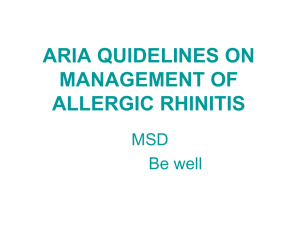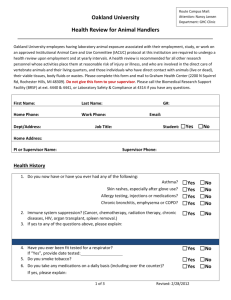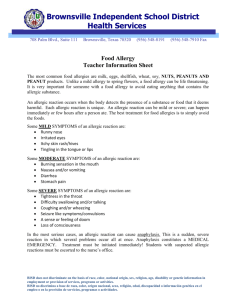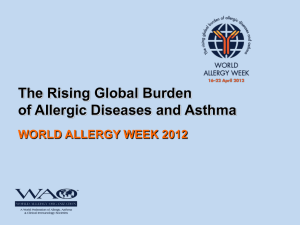allergic rhinitis with asthma
advertisement
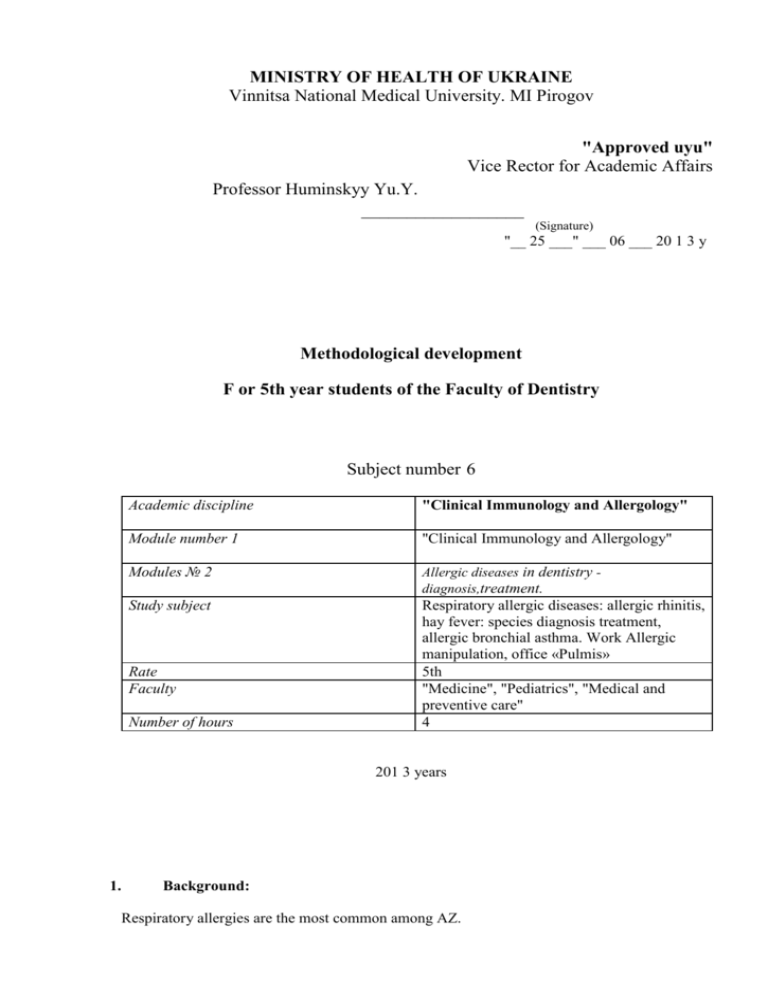
MINISTRY OF HEALTH OF UKRAINE Vinnitsa National Medical University. MI Pirogov "Approved uyu" Vice Rector for Academic Affairs Professor Huminskyy Yu.Y. __________________ (Signature) "__ 25 ___" ___ 06 ___ 20 1 3 y Methodological development F or 5th year students of the Faculty of Dentistry Subject number 6 Academic discipline "Clinical Immunology and Allergology" Module number 1 "Clinical Immunology and Allergology" Modules № 2 Allergic diseases in dentistry diagnosis,treatment. Study subject Respiratory allergic diseases: allergic rhinitis, hay fever: species diagnosis treatment, allergic bronchial asthma. Work Allergic manipulation, office «Pulmis» 5th "Medicine", "Pediatrics", "Medical and preventive care" 4 Rate Faculty Number of hours 201 3 years 1. Background: Respiratory allergies are the most common among AZ. The problem alerhich n th rhinitis is relevant for many reasons. In - First, it is connected at its rozpovsyudzhenistyu of in a large population. An important fact is i that modern methods likuva tion alerhichnoho rhinitis is not zadovi lnymy. This adversely affects the quality of life in patients with rhinitis alerhichnyy that, despite significant layer of such persons in the population of any country like a nd th us, th is important socially important. Hay fever are highly prevalent AZ recorders at affects from 3-5% to 18% of the population of different country's. His cause is hypersensitivity to pollen and spores to persons with atopy. Over the last 10 - 15 years the frequency of AR (seasonal i tsilorichnoho in European countries has risen tries her i according to past years sometimes achieved is 20%. Data are that the number of patients with AR in European countries is achieved tries her 47 million votes, i is - only registered is strovani cases. According to our data, Vinnytsta in the region over the years that have passed after the Chernobyl disaster, the frequency alerhichnoho rhinitis with growing more than udvichi. To date, the disease of asthma is the focus of pulmonologists, allergists, pathophysiologists. The high prevalence of asthma, a significant social and economic harm environmental problem, the lack of qualified medical personnel, patients neosvichchenist all this is a difficult problem for healthcare. 2. Learning Objectives (main teaching and learning issues for self pozaudytornoyi). Students should be aware that the pathology related to respiratory allergic's the disease b. Examine the types, methods of diagnosis and treatment and allergic rhinitis in th, in hay fever, know the etiology, clinical, diagnostic methods and treatment of allergic bronchial first second and asthma. Able to conduct differential diagnostics of respiratory allergic diseases with different pathologies. 3. To know: 1. Introduce students to the prevalence of respiratory AZ. 2. To acquaint students with the methods of history taking, clinical examination methods and patients with respiratory AZ. 3. To be able to formulate a diagnosis and carry out differential diagnosis between allergic rhinitis and other forms of rhinitis. 4. Know the methods of early detection and treatment of specific and nonspecific hay fever. 5. See the protocols of care for patients with allergic rhinitis (seasonal and year-round). 6.Oznayomyty students with asthma classification and principles of treatment. Be able to: 1. Collect the complaint history of the disease, history of life in patients with respiratory Z. A 2. To be able to interpret the results spirograph. 4. Baseline training. The names of the preceding disciplines 1. Human Anatomy 2. Normal physiology 3. Pathological Physiology 4. Microbiology, Virology and Immunology 5. Pharmacology 6. General hygiene General plan of the Value for breathing General pathology Types of mycobact The pharmacokine The concept of occ 5. Organization of the content of teaching material I. After greeting the students, the teacher determines Seen in this lesson. Upon checking present students respond in writing to test incoming knowledge and answer questions of the teacher. Next, the students begin to explore the topic. With anyattya held in conjunction with outpatient reception, where students have the opportunity to work with patients with pathology of respiratory allergic diseases. II. During the test, a patient teacher should pay attention to students that allergic rhinitis - is intermittent or constant inflammation of the nasal mucosa and its sinuses, which is caused by the influence of allergens and nasal manifested such symptoms as swelling, laying, itching and hypersecretion (possible the presence of only some of the symptoms). Allergic rhinitis can have easy, medium heavy and heavy flow, but can also be complicated and uncomplicated. The teacher introduces the main clinical symptoms of allergic rhinitis: itchy nose, sneezing attacks, watery discharge from the nose and laying. Often the main symptoms joins headache, decreased sense of smell, displays con 'S ktyvitu. On examination, the patient with allergic rhinitis possible to identify: characteristic of breathing with open mouth ohm m, dark circles under the eyes (arising due to stasis in peri orbital veins due to constant violation of nasal breathing) and transverse folds on the back of the nose resulting from constant rubbing patient irritable nose. In front rhinoscopy noted a significant number of white, sometimes foamy secretion in the nasal passages, sudden swelling of the nasal cavities of vasodilatation and gray or cyanotic color and spot the presence of the nasal mucosa (symptom Voyachek). Also, the teacher should pay attention to students is not something that many patients recorded a combination of allergic rhinitis and asthma. Also among the complications of allergic rhinitis is an acute and chronic otitis media, characterized by pain in the ears, especially when swallowing. This is due to dysfunction of the Eustachian tube. Also allergic otitis may occur as a purely allergic disease. The teacher should note that underestimated the importance of allergic rhinitis as a factor that reduces the quality of life and often as the initial phase of allergic asthma. The next step is a repetition of the lesson the students the basic symptoms of bronchial asthma (BA). The teacher should be noted that asthma is a disease polyetiological and has different pathogenic mechanisms, clinical polymorphism, however, as most scientists refer to it must first of all like to allergic disease. On examination, the patient with asthma may be a cough, difficulty breathing, expiratory dyspnea. Sometimes you can hear the distant whistling rales and see the swelling of the chest, especially in the upper sections.Diagnosis of asthma is based on the criteria that will be considered below. III. Dr. Lee teacher gives the definition of types of allergic rhinitis: Year-round, or persistent allergic rhinitis (PAR) - Is an allergic disease of the nasal mucosa and paranasal it in Update which are hypersensitive reactions to allergens, exposure to which is a constant. KING cause aeroalerheny following: K lischi house dust; Fungi; Waste products of cockroaches; Wool and waste products of domestic animals; Wool and waste products of commensal species (mice, rats); Occupational allergens; Laboratory animals. The main manifestations - is laying the nose, hnusavist, wheezing, mucus hypersecretion, is a sleep disorder, snoring, often joins otitis media, are nosebleeds in children. These symptoms occur throughout the year, especially in the early time of day. Sometimes PAR combined with allergic con 'yunktyvitom, signs of which are itching, redness, tearing, swelling con' yunktyvy. Diagnosis is based on the collected complaints (worsening by staying indoors), conducting skin tests of causal allergens. In mucous secretions from the nose large number of eosinophils. In conducting rynopnevmometriyi - have nasal obstruction and its gain when administered into the nose of the causal allergen. It noted significant relief in patients taking antihistamines. Seasonal (intermittent) allergic rhinitis (SAR) - Is allergic disease mucous membranes of the nose her due d and perchutlyv and Stu to aerosol allergens (pollen from plants, fungi spores), whose concentration in the air regularly cause becomes significant. CAP is part of a larger concept - the polynomial that has the same cause, but includes other manifestations (con 'yuktyvit, skin manifestations, organ lesions). The teacher lists the pollen allergens, terms of pylkuvannya in different regions of Ukraine. Depending on these terms, there are three types of hay fever: spring and summer, summer and summer-autumn. The special features include the pathogenesis of intense action and a relatively new phenomenon allergens. Validity of allergens depends on the characteristics of the immune system and organs and systems that can eliminate allergens and aeropalinolohichnyh features of a particular area. The main clinical manifestation is rhinitis. The second frequency is con 'yunktyvit, much less take place pharyngitis, otitis media, pollen asthma dermatitis, enteritis. It should be taken into account pollen intoxication, brain effects of type of epilepsy, Meniere's syndrome and visceral lesions of the liver, heart, lungs, reproductive organs, urinary tract infection. SAD is characterized by rhinorrhea, sneezing, violation of nasal breathing, itching nose, palate. The teacher notes that the diagnosis of hay fever is not severe. Main - Field collected history (acute rhinitis is manifested clearly in a certain season, strengthening manifestations in dry weather outdoors) and performing skin tests with pollen and fungal allergens and determine causative allergens. It should be noted that in Hong nasal secret contains a significant number of eosinophils. When taking antihistamines events log on to tend to disappear Here is the definition of asthma - a chronic inflammatory disease of the lower respiratory tract mainly due to the combined action of exogenous allergens and endogenous factors (atopy, susceptibility to bronchial hyperreactivity), mediated mainly mast cells and eosinophils, characterized by cough, bronchospasm (reversible in the early stages) and hypersecretion. And V. Patients with asthma attending physician with various manifestations and different im severity. The teacher introduces students to the official WHO classification according to ICD X update (1992): 1. Predominantly allergic asthma: Allergic bronchitis; allergic rhinitis with asthma; atopic asthma; exogenous allergic asthma; - Seasonal fever with asthma. 2. Nealerhichna asthma: idiosyncratic; endogenous. 3. Mixed asthma. 4. Unspecified asthma. So asthma - a chronic inflammatory disease of the airways characterized by bronchial obstruction and return variability hyperreactivity of the bronchi - increased sensitivity to various irritating stimuli. It is divided into 4 severity: intermittent, mild persistent, moderate and severe persistent asthma. Severity of symptoms is determined by the number of night / week, daytime symptoms / week, the multiplicity of application β2-agonists, short-acting, the degree of physical activity and sleep, and fluctuations in the values of FEV1 or PSV. Diagnosis is based on: 1. Clinical symptoms. 2. Violation of respiratory function. For the diagnosis of asthma patients visiting the office «Pulmis» for spirometry. The teacher shows the students schedule spirometry, abnormalities in severe cases of asthma and normal values. 3. Alerhodiahnostyka in vitro, and if necessary, in vivo. 4. Additional methods - renhenolohichnyy, immunological, biochemical, microbiological, ultrasound, and others., Which assist the differential diagnosis and detection of ABA comorbidities. At the end of the session, with the active participation of all groups of students conducted an analysis of each patient are failing patients, students are given the task of appointment and feasibility of different methods of diagnosis in each case for better learning. Method of decoding radiographs used in this lesson and in the study of certain clinical forms of asthma and implementation of differential diagnosis with other diseases. V. Then, students learn the principles of modern and treatment of respiratory allergic diseases. The teacher emphasizes that timely diagnosis, correct understanding of the mechanisms underlying the development of respiratory allergic diseases, can adequately assess the necessary amount of therapeutic aid in each case and avoid the possibility of clinical errors. Treatment of allergic diseases (EP) should be comprehensive and pursue two main objectives: to control allergic inflammation (systemic and local pharmacotherapy) and correction of the immune response (elimination of "guilty" allergen and specific immunotherapy) Treatment depends on the severity, duration of disease, the prevalence of certain symptoms with the full cooperation of the patient. 6. Plan and organizational structure of educational classes Allergology (240 minutes). Number c/o 1. Stages classes The preparatory phase Distribution time * 35 min Types of 1.1. Organizational matters. 5 min 1.2. Formation of motivation 5 min 1.3. Control of entry level of training (Standardized controls). 2. The main stage (specify all kinds of work that students perform under during this phase). Monitorin practica Familiarity wi students students with the Structured wr 25 min 120 min Oral survey poll by standa analysis of the of objective examination. test control criteria of kno 3. The final stage 25 min 3.1. Control endline training. 15 min 3.2. Overall training student activities. 3.3. Informing students the topic of the next session. 5 min 5 min Theory Note: * Forms of control and training tools specifically defined by the Department for each stage of training; Controls ** theoretical and practical training of students need to be standardized. 7. Methods of educational process in the practice (seminar) class. 7.1. The preparatory phase. Features of the clinical examination of patients with allergies and respыratorn and ERs and disease: complaints, history of disease course, ancestral history, past illnesses, working and living conditions; Physical examination methods: the value of palpation, percussion and auscultation in the examination of patients with allergic respiratory diseases. Survey methods in vivo in vitro. To acquaint students with specific goals and plan lessons. Conduct initial control level of training students in an objective examination of patients with allergic rhinitis, hay fever, allergic asthma. Identify the basic steps and provide Neuve and dkladno th auxiliary in a fit of asthma. 7.2. The main stage This phase involves performing each student independently and under the supervision of the teacher below mentioned practical work. Task 1 Students conduct survey and objective examination of the patient with respiratory allergic diseases, using inspection, palpation, auscultation, percussion. Task 2 Number 1. 2. 3. 4. 5. 6. 7. 8. 9. 10. 11. 12. Task What is the challenge alerhenmy BY perennial allergic rhinitis? Seasonal allergic rhinitis may be caused by: What sequence of clinical manifestations of hay fever (the reduction rate)? What is the sequence pylkuvannya plants? For bronchospasm characteristic auscultatory phenomenon are: The causes of bronchial obstruction may be: For diagnosis of asthma is used: In the treatment of asthma attacks primarily used: For the prevention of asthma attacks are used: Specific hyposensitization - this treatment: What drugs are o f basic drugs in the treatment of asthma? In all forms of asthma SIT is not effective? Task 3 Solve tests: 1. What shape is divided allergic rhinitis? Answer - by perennial and seasonal allergic rhinitis. 2. Name the extent the severity of allergic rhinitis? Answer - light, medium, heavy, heavy. 3. What are the classic signs of allergic rhinitis? Answer - itching, seizures, sneezing, rhinorrhea, nasal bookmarks. 4. The degree of severity of asthma? Answer - intermittent, persistent (mild, medium heavy, heavy). 5. The diagnosis of asthma is proposed on the basis of what criteria? The answer - clinical and anamnestic data, physical data, the results of skin tests, studies of respiratory function. 6. What diseases should be differentiated BA? 7. Answer - cardiac asthma, COB, bronchioles t. 8. In the presence of concomitant plerhichnoho rhinitis in asthma treatments are effective? Answer: intranasal corticosteroids, H1-histamine blockers receptor modifiers leukotrienes, specific immunotherapy 9.V most recommendations for the treatment of seasonal allergic rhinitis as primary therapy offered? A: The system nesedatyvni antihistamines 9. What is the frequency of combined allergic diseases of the upper and lower respiratory tract? Answer: in 70-80% of patients with asthma noted nasal allergies and sinus infections more Task 4 Challenges to self: №/№ 1. 2. 3. 4. 5. Task Patient perennial rhinitis, which is exacerbated when using beer muffin. What kind of an factor in question? A patient with hay fever 2 years ago appeared asthma. Takes tayled 4 times a day. W occurring 3-4 times a week, to additionally use Ventolin. Your tactics? In May, the patient, complained of itching in the nose and throat, sneezing on, rhinorrhea, r swelling povik.Usi these symptoms appeared after a trip to the country. Your diagnosis? The patient complains of asthma and rhinorrhea. An hour before it took aspirin. From histor that suffering rynosinusytom. A month ago, underwent polypectomy. Your diagnosis? The patient is a year-round runny nose, laying the nose, loss of smell. When he is on vacation trip - feels better. What kind of diseases can think of? How to examine a patient? 6. Patient seasonal allergic rhinitis. After skin tests detection causal factor - alder pollen. What preventive treatment can be assigned? 7. In weather more evident clinical hay fever? 8. What are the main allergenic components of house dust? 9. Indicate that the duration of the manifestation of symptoms of perennial allergic rhinitis? 10. How does the content of serum IgE in allergic rhinitis? 11. In hvorho (32 years) diagnosed with asthma asmy lehkohopersystuyuchoho course. Dr pharmacological group should be the basis for long-term treatment of this patient? 12. Patients aged 40 years over the past year marks the Napa di asthma that occur 2 times per week, in times a month - at night, accompanied by wheezing, neproduk ing, syndication cough. Improvement o using salbutamol. For any pathological condition characterized by the clinical data presented? Patients with asthma bi lshe 1 month Inta enjoys scrap, but lately there is difficulty in breathing at n doctor did not apply. What methods should be used to assess the effectiveness of treatment? 13. 7.3. The final stage. We estimate the current activities of each student during class, the analysis of student achievement, announced evaluation of each student and put in the log of visits and student achievement. Group leader at the same time puts assessment roll of the success and attendance of students, teacher assures them his signature. It is advisable to briefly inform students about the topic of the next lesson and instructional techniques to prepare for it. 8. Applications. 8.1. Theoretical questions preparatory phase: 1. Features collect history of the disease and the history of life on hvryh with allergic respiratory diseases. 2. The main complaint of patients with allergic rhinitis and hay fever and their characteristics. 3. The main complaint of patients with allergic asthma. 4. The main diagnostic methods in respiratory allergic diseases. 5. Basic principles of treatment of allergic rhinitis and hay fever. 6. The choice of therapy for bronchial asthma according to severity. 8.2. To formulate a diagnosis according to the clinical classification and treatment. Problem number 1. In lopchyka's '12 diagnosed with mild persistent asthma course. Drugs whose pharmacological group should be the basis for long-term treatment of this patient? A: Inhaled kosteroyidy courts. Problem number 2. Patients aged over 10 years in the past year marks the asthma attacks that occur 2 times a week, including a 3-4 times a month at night, accompanied by wheezing, nonproductive cough. Five of improvement in the following when using albuterol. For any pathological condition characterized by the clinical data presented? Answer: B ronhialna mild persistent asthma course. Problem number 3. As a boy of 14 years are year-round runny nose, nasal congestion, loss of smell. Recently started to "meet with spasmodic cough. What kind of diseases can think of? How to examine a patient? Answer: C ilorichnyy allergic rhinitis. Required testing of household allergens, consultation otoryn at lyarynholoha. Problem number 4. In hospital hospitalized patients with seasonal allergic rhinitis. After an allergy test revealed a causal factor - alder pollen. What is the optimal treatment? A: Specific immunotherapy with allergen n rychynnym Problem number 5. Female 30 years 10 years suffering from hay fever. In January nephrologist doctor about treatment of cystitis appointed Macropen, urolesa Mr. and collecting herbs. The day dawned patient itching, establishments denist nose, red eyes. The doctor determined to Macropen drug allergy and drug reversed. However, the above phenomenon is not gone, z'ya curling bronchospasm. The patient was sent to an allergist. What dia gnosis had put an allergist? A: Exacerbation of hay fever, as the gathering of herbs was appropriate plant-allergen. Problem number 6. In patient 42, who received a 2-year non-specific therapy for hay fever and a hypersensitivity to ragweed pollen was zapidoz reno prostate adenoma. In September, he turned to the urologist about discomfort during urination, pain in the abdomen. In experiment Jenny urine revealed 20 leukocytes per field, of which 15% were eozy nofily. Simultaneously, the patient expressed bothered runny nose, headache. The patient was prescribed treatment exacerbation of prostatitis as cystitis and urethritis sumamed, hentosom sitting baths, thermal breakage. True or treatment was scheduled? Answer: This exacerbation of hay fever as urethritis. To assign si systematic approach antihistaminic drug (Telfast, Aerius). Problem number 7. Patient 37 years on many years suffering from rhinitis, allergic who believes. During the reception haryachoyiyizhi, alcohol, and other dishes that he is unable to organize, he having paroxysmal attacks of sneezing, nasal discharge. Otolaryngologist at the examination, the patient did not notice pathology of the nose, the smears do not detect eosinophils but. The ophthalmologist also revealed no pathology. Skin tests with food allergens are negative. However allergist put the diagnosis of allergic rhinitis and designated treatment antihistamines. Is it the right decision adopted allergist? A: No, this variant of idiopathic rhinitis ("food rhinitis") that are not allergic. 9. Suggested Reading Basic 1. GN Drannyk: Clinical and ymmunolohyya allerholohyya. - C. - 200 6. 2. B. M. Puhlyk: Эlementarnaya allerholohyya. - Vinnitsa. - 2002. Learn more 1. BM Puhlyk: olohiya allergies. - Vinnitsa. - 2004. 2. Pыtskyy VI, NV Adryanova Allergic disease. - M., 2001. 3. E Sidorenko. N. Clinical Allergology. - 2005. 4. Roy Patterson, Leslie K. Hrezmer Paul. Allerhycheskye illness (diagnosis and Treatment). M. - 2000. Guidelines prepared Associate IV Korytska Guidelines approved at a meeting of "25" 6 0 "201 3 , the protocol number 1 Loading iduvach k afedr and MD Professor BM Puhlyk
